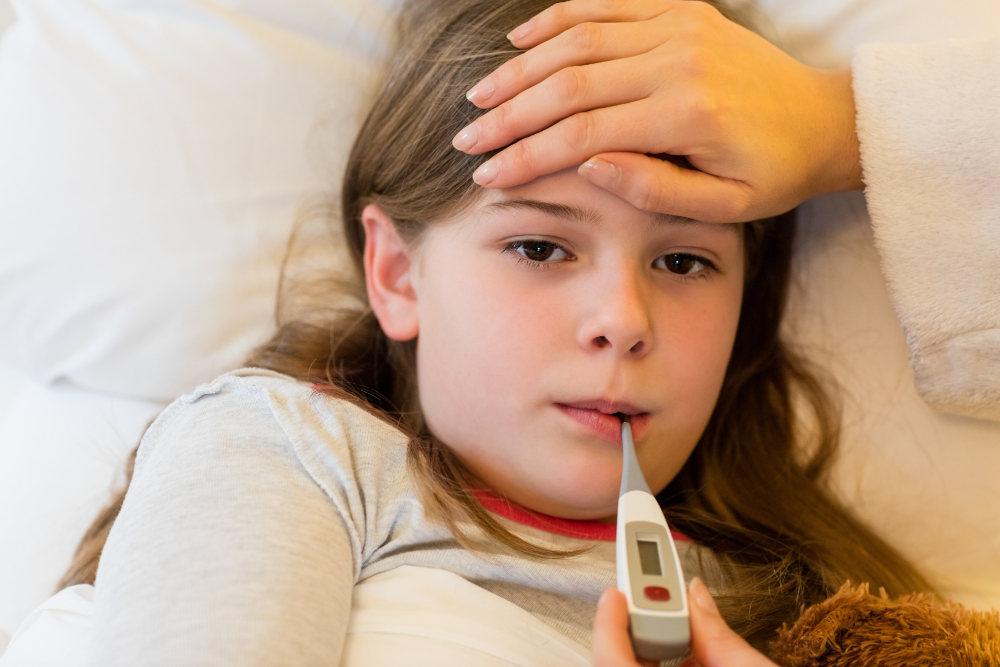Recurrent fever in children can be stressful and frustrating for parents and caregivers. It is described as the recurrence of elevated body temperature over a certain time period, frequently without an obvious explanation. Understanding the various types and categories, symptoms, causes, diagnostic processes, treatment choices, preventive measures, and expert views can help manage and reduce concerns about recurring fever in children
Types & Categories Of Fever
- Acute Fever And Chronic Fever
Acute Fever: An acute fever is a medical disorder that is described by an abrupt increase in body temperature, usually lasting less than a week. This kind of fever is frequently linked to infections like the flu, the common cold, or other bacterial and viral diseases. Other symptoms like sore throat, runny nose, cough, body aches, and weariness are frequently present in addition to acute fever. The fever is brought on by the body’s immune reaction to these diseases, which aids in the body’s defense against the invasive microorganisms. The majority of acute fevers go away on their own or with little help from a doctor, such as rest and over-the-counter antipyretics, which lower fevers.
Chronic Fever: In contrast, a chronic fever is a high temperature that lasts for a long time—usually more than three weeks. This kind of fever may indicate a more significant underlying medical issue. A persistent or recurrent fever is one that lasts longer but is frequently less severe than an acute fever. Chronic infections (like HIV or tuberculosis), autoimmune diseases (like lupus or rheumatoid arthritis), chronic inflammatory disorders, and some malignancies are possible causes of persistent fever. In contrast to acute fever, chronic fever may need more involved treatment plans and a full medical evaluation to determine its underlying cause.
-
Recurrent Fever vs. Periodic Fever Syndromes
Recurrent Fever: Recurrent fever is the term used to describe fever episodes that recure frequently and have no identifiable pattern. The length, intensity, and irregularity of the intervals between these episodes can all vary. Numerous things, such as recurrent infections, inflammatory diseases, or immune system dysfunctions, might result in recurrent fevers. Every fever episode could be brought on by a distinct underlying cause or the reactivation of an existing disease. For example, a child suffering from recurrent UTIs may have several fever episodes, each of which is linked to a different infection. Finding and treating the underlying causes of recurring fevers could require a variety of diagnostic procedures and therapeutic approaches.
Periodic Fever Syndromes: Periodic fever syndromes are defined by recurrent episodes of fever that adhere to a certain, frequently predictable pattern. Usually inherited, these diseases are caused by genetic abnormalities that impact the immune system’s ability to control inflammation. Familial Mediterranean Fever (FMF), Hyper-IgD Syndrome (HIDS), and Periodic Fever, Aphthous Stomatitis, Pharyngitis, and Adenitis (PFAPA) syndrome are a few instances of periodic fever syndromes. These syndromes frequently exhibit fever along with additional symptoms such mouth sores, sore throats, enlarged lymph nodes, and abdominal pain. These syndromes are distinguished from other forms of recurrent fevers by the regularity of their fever episodes. Treatments for recurrent fever syndromes, such as corticosteroids for PFAPA or colchicine for FMF, are typically targeted at reducing inflammation and averting flare-ups.
-
Fever of Unknown Origin (FUO)
Fever of Unknown Origin (FUO) is the term used when a child, after a complete medical evaluation, develops a fever that lasts longer than three weeks but has no discernible cause. The diagnosis of FUO is difficult and necessitates a methodical approach to determine the underlying cause of the protracted fever. Based on possible causes, it is divided into multiple categories: infectious, inflammatory (including autoimmune), neoplastic (associated to cancer), and miscellaneous. In-depth medical history taking, a thorough physical examination, and a series of diagnostic testing, such as imaging investigations, blood tests, and occasionally invasive procedures like biopsies, are all part of the evaluation process for FUO. The objective is to precisely identify the illness causing the fever and systematically rule out any other potential causes. Because of the protracted ambiguity and the possibility of major underlying diseases, FUO can be especially upsetting for families, which is why a meticulous and comprehensive diagnostic approach is crucial.
Symptoms And Signs Of Recurrent Fever In Children

Common Recurrent Fever Symptoms
To determine the underlying cause and put the right treatment plans in place, it is crucial to comprehend the whole range of symptoms and indicators connected to recurrent fever. When a fever recurs, parents and other caregivers should be aware of these symptoms and seek medical attention, particularly if the fever is accompanied by unusual or severe symptoms.
Children who have recurrent fever frequently exhibit common symptoms of high body temperature. Among them are:
Sweating: The body tries to cool itself by sweating when its temperature rises. The child may experience clammy or damp skin as a result, especially on the chest, back, and forehead.
Chills: As the body attempts to control its temperature, children who have a fever may quiver or get chills.
Flushed Skin: Increased blood flow close to the skin’s surface can cause a child’s face and body to seem flushed or red.
Fatigue: Having a recurring fever can be very taxing, which makes you feel more exhausted and demands more time for rest.
Irritability: Children who have a fever are frequently more irritable and grumpy than usual due to the discomfort and malaise that comes with it.
Uncommon Symptoms
Recurrent fever may occasionally be accompanied with less common symptoms that could indicate a more serious underlying illness like:
Severe Headaches: When accompanied by a fever, persistent or severe headaches may be a sign of meningitis or other illnesses that affect the brain and spinal cord.
Stomach Pain: If a child have persistent, severe, and unexplained stomach pain, it may indicate gastrointestinal problems or diseases such as appendicitis or inflammatory bowel disease.
Unexplained Weight Loss: Notable weight loss without a clear reason to blame might be concerning since it may indicate cancer, metabolic problems, or recurring infections.
Children’s Behavioral Changes: Parents may notice significant behavioral changes in their children during times of recurrent fever:
- Increased Fussiness: A normally peaceful child may exhibit unusual levels of fussiness that make them challenging to soothe.
- Poor Appetite: A fever can cause a child to become less interested in eating and drinking, which may lead to weakness and dehydration.
- Lethargy: Children who experience recurring fevers may seem exceptionally exhausted and sluggish displaying no interest in activities they usually find enjoyable.
Related Symptoms (such as Rashes and Joint Pain)
Other symptoms that occasionally accompany recurrent fever can offer important hints regarding the underlying cause:
Skin Rashes: A variety of rashes, including the maculopapular rash associated with viral diseases like measles or roseola, or the recognizable “butterfly” rash of lupus, can accompany fever.
Joint Pain And Swelling: Fever and joint pain, swelling, and stiffness can be symptoms of conditions such as juvenile idiopathic arthritis or other autoimmune disorders.
Swelling: Disorders like nephrotic syndrome or specific diseases may be linked to widespread swelling, often known as edema.
Sore Throat: Frequent fever and a sore throat may be signs of PFAPA syndrome, tonsillitis, or strep throat.
Lymph Node Swelling: Infections, autoimmune disorders, and cancers can all cause swollen lymph nodes, which are most common in the neck, armpits, and groin.
Causes And Risk Factors

Infectious Causes
Bacterial Infections:
Urinary Tract Infections (UTIs): Bacteria entering the urinary tract is the cause of urinary tract infections, or UTIs. Fever, discomfort in the abdomen, and pain when urinating are some of the symptoms. Young children are more likely to get UTIs, which can recure if treatment is not received.
Strep Throat: A sore throat, fever, and enlarged lymph nodes are the symptoms of strep throat, which is caused by the Streptococcus bacteria. Recurrent episodes can occur if antibiotics are not administered appropriately.
Ear Infections (Otitis Media): Pain, fever, and irritability are common symptoms of bacterial ear infections. Children, particularly those with allergies or recurrent upper respiratory infections, frequently suffer from recurrent ear infections.
Viral Infections
The Epstein-Barr Virus (EBV) is the causative agent of infectious mononucleosis. EBV can result in enlarged lymph nodes, sore throats, and recurrent fever. Some children may undergo recurring reactivation of the virus, resulting in recurrent fevers.
Cytomegalovirus (CMV): This widespread virus can produce minor symptoms in healthy children, but in those with compromised immune systems, it can cause more serious sickness and recurring fever.
Fungal Infection: Fungal infections such as candidiasis, albeit less frequent, can induce recurring fever, particularly in children with weakened immune systems. Fever, exhaustion, and localized infections are among the symptoms.
Histoplasmosis: This fungal infection can result in a persistent fever, respiratory symptoms, and systemic sickness. It is contracted by breathing in spores from contaminated soil.
Parasitic Infections
Malaria: Frequent fever episodes, chills, and sweating are the hallmarks of this disease, which is caused by Plasmodium parasites spread by mosquito bites. Tropical and subtropical areas are where it is more common, and in order to avoid problems, immediate treatment is necessary.
Giardiasis: This intestinal parasite infection can result in fever, diarrhea, and abdominal pain. It typically spreads by tainted food or drink.
Non-infectious Causes
Immune System Disorders:An autoimmune condition known as systemic lupus erythematosus (SLE) causes the body’s immune system to target healthy tissues. Recurrent fever, joint pain, rash, and inflammation of the organs are some of the symptoms.
Juvenile Idiopathic Arthritis (JIA): Is a kind of arthritis that affects children and is characterized by fever, chronic joint pain, and inflammation. Recurrent fever episodes may result from it, especially during flare-ups.
Genetic Disorders:
Familial Mediterranean Fever (FMF): Usually affecting the belly, chest, and joints, FMF is a genetic condition that produces recurrent episodes of fever and inflammation. People of Mediterranean heritage are more likely to have it, and lifetime care is necessary.
Environmental Factors
Exposure to Toxins: Frequent fever and other systemic symptoms can be brought on by exposure to certain environmental toxins, such as chemicals or heavy metals.
Allergens: Particular allergen exposure can occasionally cause recurrent fever, particularly in children who have asthma or allergy diseases.
Risk Factors
Age: Due to their immature immune systems, younger children are more prone to recurring fever. Due to their immature immune systems, infants and toddlers are especially vulnerable.
Immunization Status: Fever-producing illnesses are more common in children who have not received their full vaccination series. Immunizations guard against several types of dangerous diseases, and immunizations can protect children from many infections.
Exposure to Sick People: The risk of catching illnesses that can lead to recurrent fever increases with frequent contact with sick children or adults. This is particularly prevalent in congested housing situations, schools, and daycare centers.
Underlying Health Conditions: Children who have long-term medical conditions like diabetes, asthma, or congenital heart problems are more likely to experience fever and repeated infections. These circumstances may impair immunity or foster an atmosphere that is more conducive to infections.
Diagnoses And Tests

By combining a complete medical history, physical examination, laboratory testing, imaging studies, and expert referrals, healthcare providers can accurately determine the reason of recurrent fever and design an effective treatment plan customized to the child’s needs.
Medical History and Physical Examination
To determine the cause of recurrent fever, a thorough medical history and physical examination are essential first steps. In order to find patterns and related symptoms that might point to a particular condition, this process entails in-depth questioning and a comprehensive physical examination. Important components consist of:
Medical History: Gathering information on the child’s past illnesses, vaccination history, family medical history, and any recent travel or exposure to infectious agents. This aids in the identification of inherited diseases or risk factors.
Review of Symptoms: Talking about the length, frequency, and intensity of the fever episodes as well as any associated symptoms like rash, joint pain, or stomach problems.
Physical Assessment: completing a thorough examination to look for indications of inflammation, infection, or other anomalies. Examining the throat, ears, belly, skin, and joints for any indications of illness may fall under this category.
Lab Examinations
Laboratory investigations are necessary for detecting underlying reasons of recurrent fever. Typical exams consist of:
Blood Tests: These can detect symptoms of infection (such as higher white blood cell count), inflammation (such as increased C-reactive protein or erythrocyte sedimentation rate), or other abnormalities (such as anemia or abnormal liver function tests).
Urine Tests: Used to discover urinary tract infections or other urinary problems. A urinalysis can reveal the presence of germs, white blood cells, or other abnormalities in the urine.
Cultures: Blood, urine, or throat cultures can help pinpoint the particular bacteria causing the fever. Cultures are produced in a lab to identify specific bacteria, viruses, or fungus responsible for the infection.
Imaging Research
Imaging scans provide vital information about probable structural issues or sites of inflammation that may be causing recurrent fever:
X-Rays: Useful for detecting diseases or anomalies in the chest, such as pneumonia or TB. X-rays can also identify bone infections or other skeletal disorders.
Ultrasound: Often used to assess abdominal organs, such as the liver, kidneys, and spleen, for potential abnormalities. It can detect anomalies including abscesses, organ enlargement, or kidney stones.
MRI/CT Scans: These imaging techniques produce detailed images that can assist discover structural issues or inflammation in various sections of the body. Soft tissue examinations benefit greatly from MRI (Magnetic Resonance Imaging), whereas CT (Computerized Tomography) scans are great for obtaining fine-grained images of internal organs and bones.
Expert References
Referrals to specialists may be required if the initial examinations and testing are unable to determine the reason of recurrent fever:
Infectious Disease Specialist: When an infection is suspected but difficult to diagnose, one should consult an infectious disease specialist. These experts can suggest cutting-edge diagnostic procedures or therapies since they have experience identifying and managing complicated infections.
Rheumatologist: Expertises in autoimmune diseases such juvenile idiopathic arthritis and systemic lupus erythematosus that may result in recurrent fever. For certain ailments, they can offer customized testing and treatment schedules.
Geneticist: Involved in cases when a suspected genetic illness, like familial Mediterranean fever, exists. In addition to offering counseling regarding the implications of genetic illnesses, geneticists can do genetic testing to discover particular mutations.
Treatment Options
Preventive Measure
Hand Washing: Wash your hands frequently to avoid the transmission of illnesses.
Sanitizing Surfaces: Keeping surfaces clean to reduce the possibility of infection.
Routine Immunizations: Completing scheduled vaccines to guard against common diseases.
Special Vaccines: Based on unique risk factors or travel requirements.
Environmental Controls
Identifying and reducing exposure to recognized triggers. Keeping a clean and safe living space to promote overall health.
Conclusion
Recurrent fever in children can be caused by a variety of factors, including infections, autoimmune disorders, and genetic conditions. Accurate diagnosis and appropriate treatment are essential for managing the condition and improving the child’s quality of life.
Parents should seek medical advice if their child experiences recurrent fevers and stay informed about the latest developments in diagnosis and treatment. Maintaining good hygiene practices, ensuring timely vaccinations, and creating a healthy living environment are crucial preventive measures.



